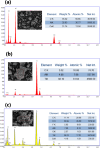Highly sensitive electrochemical determination of cariprazine using a novel Ti3C2@CoAl2O4 nanocomposite: application to pharmaceutical and biological sample analysis
- PMID: 40126677
- PMCID: PMC11933176
- DOI: 10.1007/s00604-025-07104-1
Highly sensitive electrochemical determination of cariprazine using a novel Ti3C2@CoAl2O4 nanocomposite: application to pharmaceutical and biological sample analysis
Abstract
Cariprazine (CAR) is an atypical antipsychotic drug used for the treatment of schizophrenia and bipolar disorder. This study presents the development of a novel, highly sensitive electrochemical sensor based on a Ti3C2@CoAl2O2 nanocomposite-modified glassy carbon electrode (GCE) for the detection of CAR in pharmaceutical and biological samples. The innovative Ti3C2@CoAl2O2 composite, synthesized and characterized through Fourier-transform infrared spectroscopy, X-ray diffraction, scanning electron microscopy coupled with energy-dispersive spectroscopy, and thermogravimetric analysis, revealed exceptional structural integrity, morphology, composition, and thermal stability. The electrochemical properties of the modified electrode were evaluated using cyclic voltammetry and electrochemical impedance spectroscopy, demonstrating enhanced conductivity, an increased electroactive surface area, and reduced charge transfer resistance compared to the bare GCE. Differential pulse voltammetry was employed for CAR detection under optimized conditions, yielding a linear range of 0.2-5.6 μM with a regression equation Ipa (μA) = 0.133 CCAR (μM) + 0.09 (R2 = 0.993). The limit of detection and limit of quantification were determined as 0.02 µM and 0.07 µM, respectively, highlighting the sensor's high sensitivity. The modified electrode exhibited excellent repeatability with a relative standard deviation (RSD) of = 2.9% and reproducibility (RSD = 2.8%), along with strong selectivity against common interfering substances. The sensor was successfully applied to human blood serum, urine, and CAR tablets, achieving high recovery values (98.52-103.94%), confirming its reliability for real-sample analysis. These findings underline the novelty and potential of the Ti3C2@CoAl2O2-modified GCE as a powerful tool for the accurate, selective, and sensitive determination of CAR in clinical and pharmaceutical applications.
Keywords: Cariprazine; Differential pulse voltammetry; Electrochemistry; Modified electrode; Nanocomposite; Rare disease.
© 2025. The Author(s).
Conflict of interest statement
Declarations. Ethics approval: No approval of research ethics committees was required to accomplish the goals of this study because synthetic materials were used in the experimental study. Competing interests: The authors declare no competing interests.
Figures










Similar articles
-
A novel NiCaAl-LDH@ND-COOH nanocomposite-modified electrode for highly sensitive and selective electrochemical detection of larotrectinib in pharmaceutical and biological samples.Mikrochim Acta. 2025 Aug 26;192(9):624. doi: 10.1007/s00604-025-07476-4. Mikrochim Acta. 2025. PMID: 40856872
-
Highly Specific Non-Enzymatic Electrochemical Sensor for the Detection of Uric Acid Using Carboxylated Multiwalled Carbon Nanotubes Intertwined with GdS-Gd2O3 Nanoplates in Human Urine and Serum.Langmuir. 2024 Oct 15;40(41):21427-21441. doi: 10.1021/acs.langmuir.4c02233. Epub 2024 Oct 2. Langmuir. 2024. PMID: 39356148
-
Co3O4/fluoro-copolymer nanocomposite modified boron-doped diamond electrode non-enzymatic sensor for the determination of skeletal muscle relaxant drug cyclobenzaprine in biological fluids.Talanta. 2025 May 15;287:127636. doi: 10.1016/j.talanta.2025.127636. Epub 2025 Jan 24. Talanta. 2025. PMID: 40033639
-
A sensitive nanocomposite design via carbon nanotube and silver nanoparticles: Selective probing of Emedastine Difumarate.J Pharm Biomed Anal. 2020 Mar 20;181:113096. doi: 10.1016/j.jpba.2020.113096. Epub 2020 Jan 3. J Pharm Biomed Anal. 2020. PMID: 32014685
-
Nanomaterial-assisted molecularly imprinted polymer strategies for highly sensitive and selective determination of cefdinir and its validation using computational approach.J Pharm Biomed Anal. 2024 Aug 15;246:116209. doi: 10.1016/j.jpba.2024.116209. Epub 2024 May 8. J Pharm Biomed Anal. 2024. PMID: 38759322 Review.
References
-
- McKenna PJ (2013) Schizophrenia and related syndromes: Routledge.
-
- Mauri MC, Paletta S, Di Pace C, Reggiori A, Cirnigliaro G, Valli I et al (2018) Clinical pharmacokinetics of atypical antipsychotics: an update. Clin Pharmacokinet 57:1493–1528 - PubMed
MeSH terms
Substances
LinkOut - more resources
Full Text Sources
